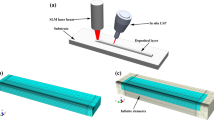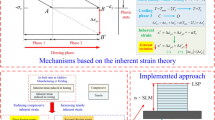Abstract
Laser shock peening (LSP) is a surface-strengthening technique that reduces residual stress in metallic parts. However, there is little literature on interlayer LSP strengthening during selective laser melting (SLM). To systematically investigate the effect of LSP on SLM residual stress, we established the removable LSP impact model based on the SLM multiple deposition layers. The mechanism by which the LSP parameters affect the residual stress of SLM is revealed. The results show that the residual tensile stress of SLM transferred to residual compressive stress due to LSP. The peak pressure of LSP is the most crucial factor for determining the residual stress field. The overlap has the second highest effect on the residual stress field due to the higher overlap causing the LSP to be repeatedly impacted at the same location. The effect of LSP diameter and full width at half maximum (FWHM) on residual stress is not as prominent as the first two. However, the appropriate LSP diameter and FWHM can reduce the residual stress hole phenomenon. This work is instructive for eliminating and controlling residual stress in metallic parts manufactured by SLM.















Similar content being viewed by others
Availability of data and materials
The data that support the findings of this study are available from the corresponding author upon reasonable request.
Code Availability
The code that supports the findings of this study is available from the corresponding author upon reasonable request.
References
Kruth JP, Leu MC, Nakagawa T (1998) Progress in additive manufacturing and rapid prototyping. CIRP Annals 47(2):525–540. https://doi.org/10.1016/s0007-8506(07)63240-5
Wu JJ, Wang LZ, An XG (2017) Numerical analysis of residual stress evolution of AlSi10Mg manufactured by selective laser melting. Optik 137:65–78. https://doi.org/10.1016/j.ijleo.2017.02.060
Zhao Z, Li L, Tan L et al (2018) Simulation of stress field during the selective laser melting process of the nickel-based superalloy, GH4169. Materials (Basel) 11(9). 10.3390/ma11091525. https://www.ncbi.nlm.nih.gov/pubmed/30149554
Ahmad B, van der Veen SO, Fitzpatrick ME et al (2018) Residual stress evaluation in selective-laser-melting additively manufactured titanium (Ti-6Al-4V) and Inconel 718 using the contour method and numerical simulation. Add Manufact 22:571–582. https://doi.org/10.1016/j.addma.2018.06.002
Liu Y, Yang Y, Wang D (2016) A study on the residual stress during selective laser melting (SLM) of metallic powder. Int J Adv Manufact Technol 87(1–4):647–656. https://doi.org/10.1007/s00170-016-8466-y
Gujba AK, Medraj M (2014) Laser peening process and its impact on materials properties in comparison with shot peening and ultrasonic impact peening. Materials (Basel) 7(12):7925–7974. https://doi.org/10.3390/ma7127925
Peyre P, Berthe L, Vignal V et al (2012) Analysis of laser shock waves and resulting surface deformations in an Al-Cu-Li aluminum alloy. J Physi D: Appl Phys 45(33):335,304. https://doi.org/10.1088/0022-3727/45/33/335304
Sun R, Li L, Guo W et al (2018) Laser shock peening induced fatigue crack retardation in Ti-17 titanium alloy. Mater Sci Eng A 737:94–104. https://doi.org/10.1016/j.msea.2018.09.016
Lu JZ, Duan HF, Luo KY et al (2017) Tensile properties and surface nanocrystallization analyses of H62 brass subjected to room-temperature and warm laser shock peening. J Alloys Comp 698:633–642. https://doi.org/10.1016/j.jallcom.2016.12.210
Lu J, Lu H, Xu X et al (2020) High-performance integrated additive manufacturing with laser shock peening -induced microstructural evolution and improvement in mechanical properties of Ti6Al4V alloy components. Int J Mach Tools Manufacture 148(103):475. https://doi.org/10.1016/j.ijmachtools.2019.103475
Azer M, Scheidt D (2004) The influence of spot overlap and laser flence on the high cycle fatigue (HCF) strength of aircraft engine fan blades. In: ICALEO 2004 - 23rd International congress on applications of laser and electro-optics, congress proceedings. Laser Institute of America, United States, p 1401. https://doi.org/10.2351/1.5060214
Peyre P, Scherpereel X, Berthe L et al (1998) Current trends in laser shock processing. Surf Eng 14(5):377–380. https://doi.org/10.1179/sur.1998.14.5.377
Chen H, Wei C, Wang S et al (2021) Effects of laser shock peening on the properties and microstructure evolution of laser-polished surface of Cr12 steel. J Laser Appl 33(3). https://doi.org/10.2351/7.0000395
Chi J, Cai Z, Wan Z et al (2020) Effects of heat treatment combined with laser shock peening on wire and arc additive manufactured Ti17 titanium alloy: microstructures, residual stress and mechanical properties. Surf Coat Technol 396(125):908. https://doi.org/10.1016/j.surfcoat.2020.125908
Wei XL, Ling X (2014) Numerical modeling of residual stress induced by laser shock processing. Appl Surf Sci 301:557–563. https://doi.org/10.1016/j.apsusc.2014.02.128
Wang M, Wang C, Tao X et al (2022) Numerical study on laser shock peening of pure Al correlating with laser shock wave. Materials (Basel) 15(20). https://doi.org/10.3390/ma15207051
Cao Y, Wang Z, Shi W et al (2022) Formation mechanism and weights analysis of residual stress holes in E690 high-strength steel by laser shock peening. Coat 12(2). https://doi.org/10.3390/coatings12020285
Kim JS, Nam HS, Kim YJ et al (2017) Numerical study of laser shock peening effects on Alloy 600 nozzles with initial residual stresses. J Pres Vessel Technol 139(4):041,406. https://doi.org/10.1115/1.4035977
Xu GX, Wu CS, Qin GL et al (2011) Adaptive volumetric heat source models for laser beam and laser + pulsed GMAW hybrid welding processes. Int J Adv Manu Technol 57(1–4):245–255. https://doi.org/10.1007/s00170-011-3274-x
Qiu C, Panwisawas C, Ward M et al (2015) On the role of melt flow into the surface structure and porosity development during selective laser melting. Acta Materialia 96:72–79. https://doi.org/10.1016/j.actamat.2015.06.004
Johnson GR, Cook WH (1985) Fracture characteristics of three metals subjected to various strains, strain rates, temperatures and pressures. Eng Frac Mech 21(1):31–48. https://doi.org/10.1016/0013-7944(85)90052-9
Zhou Z, Gill AS, Qian D et al (2011) A finite element study of thermal relaxation of residual stress in laser shock peened IN718 superalloy. Int J Impact Eng 38(7):590–596. https://doi.org/10.1016/j.ijimpeng.2011.02.006
Fabbro R, Fournier J, Ballard P et al (1990) Physical study of laser-produced plasma in confined geometry. J Appl Phys 68(2):775–784. https://doi.org/10.1063/1.346783
METALS HT (2022) Inconel 718 technical data. http://www.hightempmetals.com/techdata/hitempInconel718data.php#6
Romano J, Ladani L, Sadowski M (2016) Laser additive melting and solidification of Inconel 718: finite element simulation and experiment. Jom 68(3):967–977. https://doi.org/10.1007/s11837-015-1765-1
Denlinger ER (2018) Thermomechanical model development and in situ experimental validation of the laser powder-bed fusion process * * Should note that some content from this chapter was recently published: Denlinger, Erik R., et al “ Thermomechanical model development and in situ experimental validation of the Laser Powder-Bed Fusion Process.” Add Manu (2017), pp 215–227. https://doi.org/10.1016/b978-0-12-811820-7.00016-1
Pottlacher G, Hosaeus H, Wilthan B et al (2002) Thermophysikalische eigenschaften von festem und flüssigem Inconel 718. Thermochimica Acta 382(1–2):255–267. https://doi.org/10.1016/s0040-6031(01)00751-1
Cao L (2021) Workpiece-scale numerical simulations of SLM molten pool dynamic behavior of 316L stainless steel. Comput Math Appl 96:209–228. https://doi.org/10.1016/j.camwa.2020.04.020
Hadley GR (1986) Thermal conductivity of packed metal powders. Int J Heat Mass Trans 29(6):909–920. https://doi.org/10.1016/0017-9310(86)90186-9
Mercelis P, Kruth J (2006) Residual stresses in selective laser sintering and selective laser melting. Rapid Prot J 12(5):254–265. https://doi.org/10.1108/13552540610707013
Zhao ZY, Li L, Bai PK et al (2018) The heat treatment influence on the microstructure and hardness of TC4 titanium alloy manufactured via selective laser melting. Materials (Basel) 11(8). https://doi.org/10.3390/ma11081318
Lu G, Wang D, Gao S et al (2022) Will the laser shock-induced residual stress hole inevitably occur? J Mat Res Technol 18:3626–3630. https://doi.org/10.1016/j.jmrt.2022.04.017
Abhishek, Panda SS, Kumar S (2022) Numerical analysis on residual stress hole generation in laser shock peening. European Phys J Plus 137(4). https://doi.org/10.1140/epjp/s13360-022-02638-2
Pei Y, Duan C (2017) Study on stress-wave propagation and residual stress distribution of Ti-17 titanium alloy by laser shock peening. J Appl Phys 122(193):102. https://doi.org/10.1063/1.5001724
Peyre P, Fabbro R, Merrien P et al (1996) Laser shock processing of aluminium alloys. Application to high cycle fatigue behaviour. Mater Sci Eng: A 210(1-2):102–113. https://doi.org/10.1016/0921-5093(95)10084-9
Braisted W, Brockman R (1999) Finite element simulation of laser shock peening. Int J Fatigue 21(7):719–724. https://doi.org/10.1016/s0142-1123(99)00035-3
Sun B, Qiao H, Zhao J (2018) Accurate numerical modeling of residual stress fields induced by laser shock peening. AIP Advances 8(9). https://doi.org/10.1063/1.5039674
Funding
The present work was supported by the National Science Foundation of China (no. 51871012, 52071021) and Fundamental Research Funds for the Central Universities (no. FRF-GF-20-20B).
Author information
Authors and Affiliations
Contributions
Xianlong Li: methodology, formal analysis, writing—original draft preparation, data curation, visualization. Laiqi Zhang: conceptualization, funding acquisition, writing—review and editing. Xu Wei: visualization, investigation.
Corresponding author
Ethics declarations
Ethics approval
This work does not involve human ethical issues. Moreover, we promise to follow the COPE guidelines on how to deal with potential acts of misconduct.
Consent to participate
All authors consent to participate in this work.
Consent for publication
All authors have agreed to publish this manuscript.
Conflict of interest
The authors declare that we have no financial and personal relationships with other people or organizations that can inappropriately influence our work, there is no professional or other personal interest of any nature or kind in any product, service and/or company that could be construed as influencing the position presented in, or the review of the manuscript entitled.
Additional information
Publisher's Note
Springer Nature remains neutral with regard to jurisdictional claims in published maps and institutional affiliations.
Laiqi Zhang and Xu Wei contributed equally to this work.
Rights and permissions
Springer Nature or its licensor (e.g. a society or other partner) holds exclusive rights to this article under a publishing agreement with the author(s) or other rightsholder(s); author self-archiving of the accepted manuscript version of this article is solely governed by the terms of such publishing agreement and applicable law.
About this article
Cite this article
Li, X., Zhang, L. & Wei, X. Effect of interlayer laser shock peening on residual stress induced by selective laser melting. Int J Adv Manuf Technol 129, 611–628 (2023). https://doi.org/10.1007/s00170-023-12278-0
Received:
Accepted:
Published:
Issue Date:
DOI: https://doi.org/10.1007/s00170-023-12278-0




